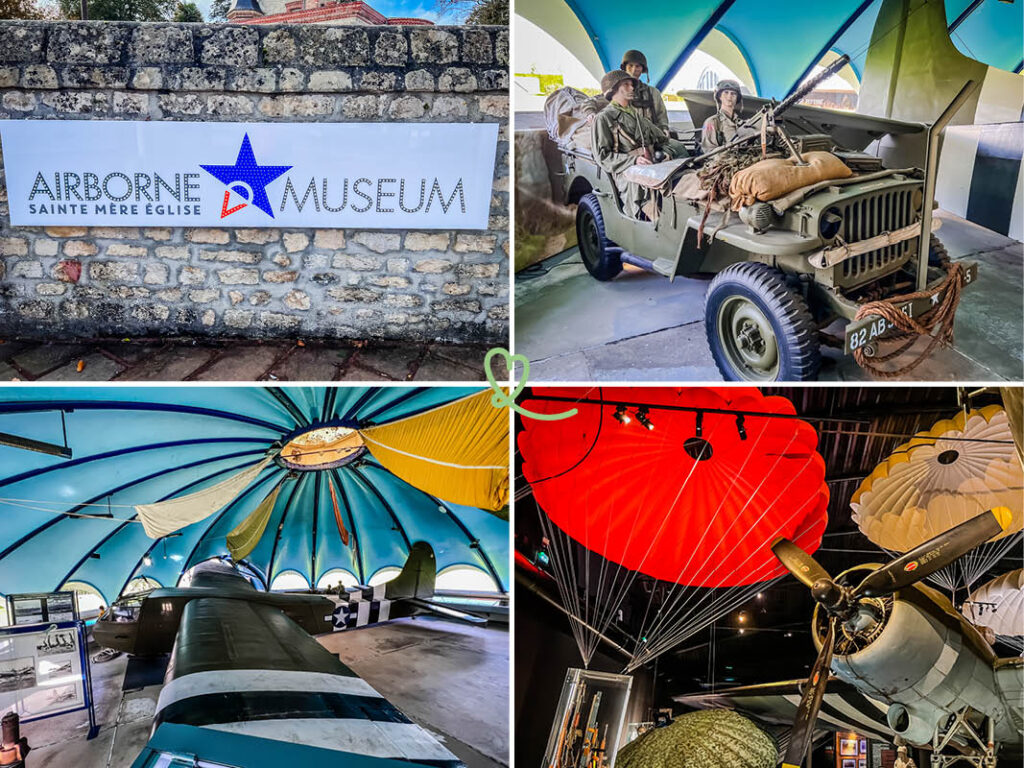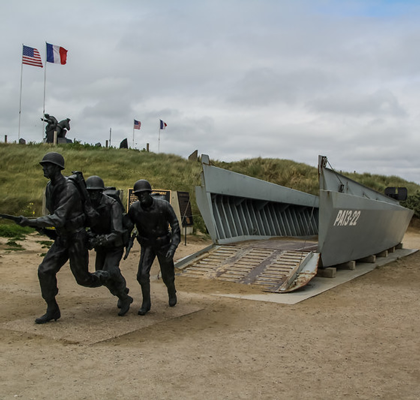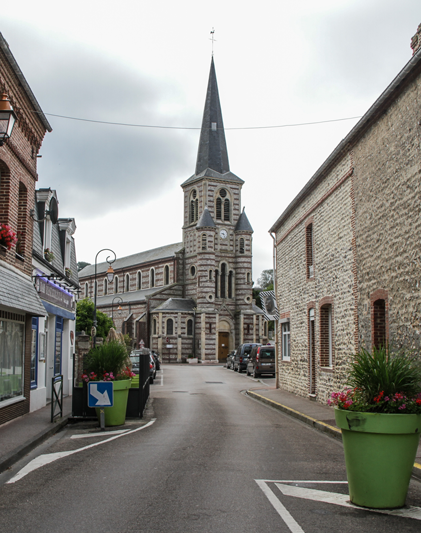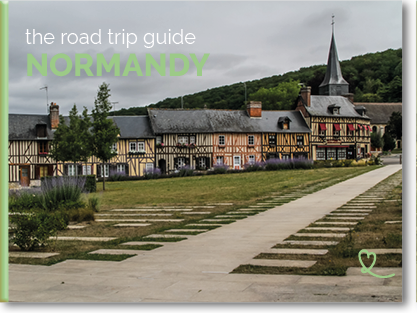You can’t pass through the D-Day beaches without visiting the Airborne Museum, dedicated to American airborne troops in June 1944. Located a 15-minute drive fromUtah Beach, this museum owes its fame to paratrooper John Steele. Hanging from the steeple of Sainte-Mère-Église on June 4, 1944, he inspired the famous film The Longest Day .
Through this visit, you will be led to relive D-Day in total immersion from its preparation by the Allies to the (re)conquest of freedom.
In this article, find our opinion in pictures and all our advice to prepare your visit.

This review is completely independent, we visited anonymously and paid our admission in full.
Why visit the Musée des troupes aéroportées – Airborne Museum?
Is the Airborne Museum worth it? In our opinion:
The Airborne Museum is Europe’s largest museum dedicated to the American paratroopers of the 82nd and 101st Airborne Divisions. It is particularly interesting for visitors with a passion for aviation or war history.

Unlike other D-Day museums, this one pays special tribute to the soldiers who came from the sky. Through an impressive scenography (hyper-realistic reconstructions, films, holograms, digital tablets…), we discovered in a highly interactive way the decisive role played by these soldiers in the Battle of Normandy.
The museum also boasts a number of collectors’ items, including parachute canopies, uniforms, everyday objects, authentic vehicles and genuine vintage aircraft. So, are you ready for adventure? Don’t forget to reserve your time!

Why is the Airborne Museum famous?
This museum is famous for several reasons:
- This is the only museum where you can learn about the preparation and execution of the Normandy landings by airborne troops. It features unique exhibits such as the Waco glider and the C-47 aircraft.

- The Airborne Museum continues to represent the strong link between American servicemen and the people of Sainte-Mère-Église in Normandy. The Walkway Victory Memorial Bricks pay tribute to these soldiers.

- Located opposite Sainte-Mère-Église church, the museum benefits from the village’s international reputation. It was here that part of the history of the Second World War was played out: the landing of the airborne troops.

- The museum is also famous for the film The Longest Day, which recounts John Steele’s remarkable landing. The American parachutist ended up clinging to the steeple of Sainte-Mère-Église.

Our favorite moments
We particularly enjoyed discovering the American Waco glider in the 1st pavilion. We had the chance toclimb aboard the life-sizeplane and imagine ourselves in the shoes of American paratroopers. This is the only example of a Waco glider still in its entirety in France. Thanks to the Histopad (a touch-sensitive tablet provided), we could even visualize ourselves at the controls of the machine!

In the C-47 building, we also loved the interactive staging. We were able to watch the paratroopers’ briefing with a larger-than-life hologram, and prepare to jump with them.

Finally in the building “ Opération Neptune”, the 4D aircraft experience immersed us in the action. Through the mix of sounds, images and movements, we felt as if we were living the events from the inside!
Each pavilion offers a different experience that will appeal to all audiences. Check availability and reserve your place!
A little history
Sainte-Mère-Église is a Normandy village linked with airborne troops during the Normandy Landings. On June 6, 1944, American paratroopers from the 82nd and 101st Divisions were dropped on the Sainte-Mère-Église region to secure the area.

Despite scattered landings, they succeeded in establishing a bridgehead crucial to the success of D-Day. The village became a symbol of Operation Overlord, and today houses the Airborne Museum, the only museum dedicated to the history of the airborne troops.

MORE ABOUT THE D-Day sites
- The best landing sites to visit
- Visit the 5 D-Day landing beaches
- Where to stay – best hotels near the beach
- The best D-Day museums in Normandy
- German batteries to visit
- Car rental tips: Caen – Roissy-CDG – Orly – Beauvais
- Visit Omaha Beach
- Visit Utah Beach
- Visit Gold Beach
- Visit Sword Beach
- Visit Juno Beach (coming soon)

Useful tips and map: Airborne Museum, Sainte-Mère-Eglise, France
Where is the Airborne Museum?
The Airborne Museum is located at 14 Rue Eisenhower in Sainte-Mère-Église (50480) in Normandy.
OUR ADVICE FOR RENTING A CAR IN Normandy
- Compare prices on our preferred platform: DiscoverCars – one of the best rated sites.
- Choose a car that is comfortable enough (distances can be long) but compact (some parking lots and villages are narrow).
- Think of thecomplete insurance (some roads are tortuous and narrow).
- There is a lot of demand, book it early.

- Driving time from Rouen: 2h15min.
- Driving time from Evreux: 2h35min.
- Driving time from Caen: 1 hour.
- Driving time from Alençon: 2h10.
- Driving time from Cherbourg: 40min.
These times may vary depending on traffic conditions.
How to get there
The Airborne Troops Museum is easily accessible by car. Located on the village’s church square, you’ll have no trouble locating it.
The museum can be reached by public transport from Paris, Bayeux, Caen or Cherbourg. Carentan station, on the Paris-Cherbourg TER line, is a 14 km drive from Sainte-Mère-Église.
See available timetables and book your train and coach tickets now.
In Carentan, you can take a cab to the museum in 15 minutes, or catch a line 1 bus to Cherbourg-Octeville for €3. Nomad bus line 301 also links Carentan-les-Marais to Sainte-Mère-Eglise. Find bus timetables here.
The car remains the most practical means of transport. You can get there quickly from Normandy’s main towns via the N13. Its proximity to the American cemetery at Colleville-sur-Mer and the D-Day beaches (Utah Beach is a 15-minute drive away), makes it an ideal place to plan your trip to discover the emblematic sites of D-Day.

On an organized tour from Paris, Bayeux or Caen, you can opt for private excursions from Paris, Bagneux or Caen. These include a visit to the Airborne Museum, as well as other D-Day landmarks such as cemeteries and beaches.
Discover the options and book your time slot now.
Parking
The museum does not have its own parking lot, but it is surrounded by large municipal parking lots. You’ll find one behind the museum on rue du Docteur Masselin, as well as on Place de l’Église and opposite the museum. These parking lots are not free. They cost €2 per 24 hours.
The site has a bicycle parking and is accessible to campers.

Best time to visit the Airborne Museum
It’s always busy between 11am and 5pm, especially in summer. Nevertheless, it’s easy to get around, as the museum has plenty of space. If you want to avoid the crowds, it’s best to get there early in the morning or late in the afternoon. However, the Airborne Museum is large, so it’s easy to get around. This unique museum attracts visitors all year round, so check availability and book now.

How long to visit the museum and main difficulties
It takes between 1 and 3 hours to visit the museum which is spread over 4 buildings.
For the more passionate among you, you will have to allow more time to read the numerous informative panels.

The museum is home to a wealth of airborne memorabilia. You’ll find it easy to navigate through the museum. Most of the site is accessible to people with reduced mobility.
The ground is flat and there are few stairs. Buildings are either level or equipped with ramps. Only one platform in pavilion C-47 is inaccessible.

Restrooms are located in the museum’s reception building, next to the store, and in Pavilion 3.
If you are visiting this museum with small children, whether you are in a stroller, on foot or in a baby carrier, the visit is still feasible.
Information is available mainly in English and French.
It should be noted that the visual and sound environment of certain sections may be difficult to bear for people with hypersensitivity.

Map of the Airborne Museum and advice on how to visit
As indicated on the museum map, it’s best to start your visit with Building 1, dedicated to the Waco glider. Building 2 then presents the C-47 aircraft and its history. The 3rd building, “Operation Neptune”, refurbished in 2021, highlights new themes, such as wartime medicine, the duty of remembrance and civilians during the liberation. Finally, the 4th building is a conference center/cinema.
We advise you to follow the order of the plan which ensures a chronological and coherent continuity in this immersion through the history of war.

OUR ADVICE FOR RENTING A CAR IN Normandy
- Compare prices on our preferred platform: DiscoverCars – one of the best rated sites.
- Choose a car that is comfortable enough (distances can be long) but compact (some parking lots and villages are narrow).
- Think of thecomplete insurance (some roads are tortuous and narrow).
- There is a lot of demand, book it early.

Guided tours
The museum does not offer guided tours for individual visitors.
An interesting alternative to the traditional guided tour was suggested to us: the use of the Histopad, a touch-sensitive tablet that considerably enriches the visiting experience. Included with the admission ticket, this tool enables visitors to learn more about the objects on display, or to access previously unpublished content (photographs, animated maps, archives, etc.). It extends the immersive dimension of the visit, thanks to 360° reconstructions in augmented reality, which plunge the user into the history of Sainte-Mère-Église under the Occupation and during the summer of 1944.

A 30min tour of the museum’s reserves (or backstage) by a curator has also been on offer since March 2023. More information on the museum’s official website.
Museum of Airborne Troops with children
The interactive and immersive dimension of the museum is well thought out for children. Thanks to the Histopad, your little ones can set off in search of war relics hidden in the museum: a real treasure hunt! To keep a souvenir of their visit, the tablet also lets them take photos of themselves in paratrooper, soldier or nurse outfits.
The Airborne Museum has been designed with children in mind, with a special tour dedicated to them. For an even more fun-filled visit, 3 game books for ages 6 to 15, as well as coloring pages, can be downloaded free of charge from the official website.

Schedules and prices
The museum is open every day:
- From May to August: 9am-7pm (last entry at 6pm).
- In April and September: 9:30 am – 6:30 pm (last entry at 5:30 pm).
- From October to March: 10am-6pm (last entry at 5pm).
Every year, the museum closes in December and January, except during school vacations. It is also closed for the holidays (December 24, 25, 31 and January 1).
Rates:
- Full price adult ticket : 9,90
- Children’s ticket: 6€ for children from 6 to 17 years old, free entrance for children under 6 years old.
- Special family rate (from 2 adults and 2 children): 28€ (9€/adult and 5€/child)
The visit to the museum reserves is available at a single price of 14.90€ per adult and 10€ per child, and includes admission to the museum.
Check out the schedules, all the rates, and book your tickets on the official website.
Subscribe to our Newsletter
- Get away from it all with Region Lovers’ beautiful destinations!
- Once a month
- Advertising-free
Restaurant nearby
The museum doesn’t offer snacks or restaurants, but you’ll easily find them in and around Sainte-Mère-Église. Or bring your own packed lunch! Picnic tables are available in the village.
Otherwise you have easy access to a selection of restaurants and snack bars in the village.
For the restaurants, we recommend:
- Restaurant le Bistrot 44, located in the heart of Sainte-Mère-Eglise, you will enjoy simple but generous dishes at reasonable prices.
- Crêperie Chez Jeanne, you can enjoy traditional Norman pancakes in a warm setting!
If you have a car and would like to visit the surrounding area, the town of Bayeux, a 40-minute drive away, also has a very good choice of restaurants. See our selection of the best restaurants in Bayeux.
STAYING NEAR THE D-Day beaches
Option 1: Bayeux
The most practical option, in our opinion, is to base ourselves in the town of Bayeux. We recommend..:
- Hotel Domaine de Bayeux in an 18th century mansion – see prices, photos and availability
- see all top rated accommodations in Bayeux

Option 2: in the countryside
In the countryside around the D-Day beaches, you will find beautiful buildings with a lot of charm: farms, manors…
- Hotel Domaine d’Utah Beach – prices, pictures and availability
- Hotel Ferme de la Rançonnière – prices, pictures and availability

Option 3: next to one of the beaches
If you’re looking for a seaside holiday or are fascinated by one of the beaches, you can choose a more specific hotel:
- Hotel Villas d’Arromanches in Gold Beach Beach – prices, pictures and availability
- Hotel La Sapinière in Omaha Beach Beach – prices, pictures and availability

Start of the tour: Zone 1 – Waco Glider Room
The plane
The tour begins with Building 1. If you take the time to look closely at the roof, you’ll see that it’s shaped like a parachute. Clever, isn’t it?
We had the pleasure of seeing the life-size Waco CG4A glider in the center of the room.

With a wingspan of 25.5m and a length of 14.8m, it is the only example of this type to be seen in France. The wreckage of this glider has been entirely renovated by the Salis workshops at La Ferté-Alais. You’ll have the incredible opportunity to climb aboard, and discover its history through explanatory panels. We loved the experience, and even discovered with the Histopad how the cannons were loaded into the plane!

The Waco glider is an important part of the museum’s history. As early as 1957, the mayor of Sainte-Mère-Église submitted his plan to create a museum to the American and French authorities.
The centerpiece would be a glider used for landing airborne troops. In 1960, the Americans located the wreckage of a 1943 Waco CG4A glider, which was later restored in the Paris region.

The objects
All kinds of objects are on display in this room. We looked at everyday items such as soldiers’ personal effects and weapons, as well as equipment like these dust goggles.

We were surprised by the attention to detail. Hygiene products and medical equipment were also on display.
The objects that interested us the most were:
- parachutists’ equipment: parachutes, life jackets, army helmets, jumping boots, goggles,
- medical kit: a first aid kit containing an individual bandage, a tourniquet, morphine and a packet of disinfectant powder.
The paratroopers were already well equipped at that time!

The canopies
One of the display cases caught our eye. The parachute museum has a collection of canopies, and visitors can see how they are used. We learned that there were different colors of canopy for dropping containers, and that each had a different meaning.

To give you an example:
- If the canopy is white, it means that you will find equipment and material in the container.
- While a blue canopy indicates that the container contains food.
We really enjoyed the experience of flying full-size planes! It gave us an insight into living conditions during the war.

USE OUR GUIDE TO PLAN A
DREAM TRIP TO Normandy
All the information you need for your trip:
- 8 maps that make planning easier
- 160+ pre-selected locations
- Practical advice
- 300+ photos to help you choose

Continuation of the visit in Zone 2 – Pavilion C47
In building 2, whose roof is shaped like a Delta wing, you will discover the legendary Douglas C-47 Skytrain proudly towers above us. But before we got too close, we were delighted to be able to watch parachutists in action. In fact, the museum has recreated jump scenes using fully-equipped mannequins: jump boots, helmets, special jackets and pants, and of course parachutes!

You will also have access to more information via explanatory panels.
If you’re passionate about the U.S. military, you’ll appreciate the information on U.S. paratrooper insignia. The touch screen in this section allowed us to learn more about the colors, signs and their meanings.

We then devoted ourselves to the observation of the most important piece of the Zone 2: the Douglas C-47 Skytrain aircraft.

This aircraft dropped paratroopers over Sainte-Mère-Église on June 6, 1944, along with 821 other C47 aircraft. They were used to parachute 13,348 men from the 82nd and 101st Airborne Divisions. These planes were also used to tow gliders on D and D+1. Impressive!
We enjoyed learning about the history of the American paratroopers (formation of regiments, evolution of equipment, early combat…). Explanations are given of the military operations that led to the success of the D-Day landings, itself told through a film on a giant screen.

The course also allows to understand the role of the “pathfinders”, soldiers in charge of marking the jumping areas.
The Briefing
It was in this pavilion that we entered the “briefing” room. We were immersed in an American wooden barracks, recreated with posters from the period and trompe-l’oeil windows overlooking airfields.

The hologram of a soldier appeared: in the skin of a parachutist, we received orders to equip ourselves before the big jump. So listen carefully, and good luck!

The Big Bluff
Operation Bodyguard was a vast plan of diversion and disinformation, set up by the Allies, to mislead the German armies on the places of the various landings in Europe.

The objective of this “Great Bluff” was to mislead the German enemies by:
- creating ghost units in England and Scotland,
- disseminating information classified as secret and controlled by the intelligence services,
- deploying double agents among the German troops.

In this section, the explanatory panels and various objects exposed allowed us to understand the extent of this device: diffusion of false information, double agents, guns, tanks, dummies and false insignia, everything was implemented to hide the true intentions of the Allies! Don’t forget to book your visit!
Story and testimony
In the C-47 building, we have “met” the actors of this tremendous epic. You can listen to the paratroopers’ conversations, and read testimonials from the period.

Since its creation, the museum has been linked to the paratroopers who liberated Sainte-Mère-Église. The veterans were present at the inauguration of the museum’s various pavilions. So, naturally, we found stories and portraits of soldiers throughout the visit.

For example, the life of Maxwell D. Taylor, commander-in-chief of the 101st Airborne Division, is retraced. Never-before-released recordings are available, and the crew of the C-47 are introduced.

Through realistic portraits and stories, the paratroopers reveal their humanity and their living conditions. This brings them closer to us, and makes their world more tangible.

German side
In May 1944, a few weeks before the D-Day landings, the Germans reinforced their defense of the Cotentin Peninsula:
- The 243rd Infantry-Division was positioned on the northwest coast.
- The 709th Infantry-Division covered the northeast coastal sector.
- The 91st Division established itself in the center of the Cotentin.
- Installation of heavy artillery batteries.
The German army equipped itself to counter the enemy offensive and protect the coastline.

Films based on archive footage helped us to visualize the situation at the time. The museum’s scenography is totally immersive, and it’s great to be able to put yourself in the soldiers’ shoes during the visit!

Zone 3 – Operation Neptune
Direction: the 3rd building in the shape of an airplane wing, named “Operation Neptune”. This pavilion immersed us in the airborne troops who landed at Sainte-Mère-Église. The immersion begins aboard a C-47 in England, and ends with the big jump over the Normandy village.

The 4D experience
In this pavilion, you will relive the parachute drops of June 6, 1944 as if you were there!

The 4D experience is impressive: under our feet and through the windows of the C-47, images flash by. With the noises, sounds and movements given to the aircraft, we were able to imagine the visual and aural chaos experienced by the paratroopers on the way to their mission. You’ll feel like you’re in a real airplane in wartime as you move through the narrow corridors.

Sainte-Mère-Église
The Airborne Museum is not located in Sainte-Mère-Église by chance! It’s a town steeped in history, and deeply marked by the D-Day landings.

Operation Neptune, told through a very realistic museography, plunges into the heart of the battle of Sainte-Mère-Eglise which began on June 6, 1944.
- June 6, 1944 – 1:00 a.m.: the first Allied paratroopers landed in Saint-Mère-Église and launched the assault.
- June 6, 1944 – 5am: the Germans retreat and Sainte-Mère-Église becomes the 1st city liberated by the American airborne troops.
- June 6 and 7, 1944: the German counter-attack was organized and led to intense fighting.

The American paratroopers held out until reinforcements arrived. The town was never retaken by the enemy!
Sainte-Mère-Église also owes its fame to John Steele, an American parachutist who remained suspended from the bell tower of the village church.

In 1961, the film The Longest Day was shot here, featuring such luminaries of the time as John Wayne, Henry Fonda and Sean Connery, and immortalizing this cult moment. The biopic is adapted from Cornelius Ryan’s 1959 book of the same name.

You can see that the parachutist is still hanging from the bell tower of the church of Sainte-Mère-Église!
Combat scenes
At the Airborne Museum, you will be able to dive into the heart of the confrontations thanks to reconstructions of combat scenes.

The violence of the assaults on Sainte-Mère-Église is without comparison. During the battle of Fière, which lasted just 3 days, both sides suffered heavy losses in men and material.

The village experienced many other battles during this period.
The liberation of Sainte-Mère-Eglise cost the lives of many soldiers, as well as civilians. To the north of the village, on June 7, the Germans fought back. To the west, in the marshes, intense fighting took place until June 9 (Battle of La Fière). These battles are portrayed in hyper-realistic detail.
Subscribe to our Newsletter
- Get away from it all with Region Lovers’ beautiful destinations!
- Once a month
- Advertising-free
And around the buildings
Vehicles
Outside the museum are war vehicles, such as the Sherman M4 tank or the American war truck CGM CCKW 353.

The latter is the most famous and widespread cargo model of the US Army.

Walkway Victory Memorial bricks
The Walkway Victory Memorial bricks is a memorial site created at the initiative of The Regan Legacy Foundation.

This unique place is dedicated to the commemoration of American veterans who served alongside the Allies in the Second World War. It’s a place to reflect and honor their memory.
For the more informed among you, you can also test your knowledge by trying to recognize names.

So all this has made you want to visit the Airborne Museum, the only museum dedicated to airborne troops during World War II? Don’t wait any longer and reserve your slot to avoid waiting in line!
PLAN YOUR TRIP TO Normandy
Inspiration destinations
- Deciding where to go in Normandy – the best destinations
- Our weekend ideas: best-of, romantic, unusual, seaside, luxury, family
- 16 seaside hotels in Normandy
- The most beautiful charming hotels in Normandy

Best of

Practice
- Where to stay in Normandy – best places and hotels
- See our tips for renting a car at CDG airport, Orly airport, Beauvais airport, Caen, Rouen, Bayeux…

What to see in Sainte-Mère-Église and surroundings
Visit the village of Sainte-Mère-Église
Sainte-Mère-Église is a charming commune in the Manche département. Known for its Airborne Museum, you can also visit the famous Church of Notre-Dame de l’Assomption, from whose roof paratrooper John Steele hung in 1944. But the village is also home to..:
- the Farm-Museum of Cotentin which retraces the life in the countryside in post-war Normandy,
- the Fiere Bridge and Iron Mike Monument a strategic bridge during World War II and an emotional place of remembrance,
- the Brewery of Sainte-Mère-Église which makes very good craft beers for the connoisseurs.
Find all the activities in Normandy including the visit of the village of Sainte-Mère-Église by clicking here.

Take an excursion to Mont-Saint-Michel
Have you heard of the Merveille sur le mont dating back to the Middle Ages? This jewel perched on a rock is a true architectural feat! We’ve named it the famous Mont-Saint-Michel! If you’re passing through Normandy and have never visited this magical place, we highly recommend it.
The ideal way to get there is with an organized tour, so you can sit back on a bus, relax on the way and enjoy this unique place. See tour options on Viator or Getyourguide.

By road, Mont-Saint-Michel is 1.5 hours from the village of Sainte-Mère-Église and around 4 hours from Paris. Here you’ll find all our advice on how to get to Mont-Saint-Michel (car, tours, train…).

Visit the key places of the Landing
You also have the possibility in the vicinity of:
- Discover the most beautiful D-Day beaches, emblematic places of this turning point in history: the 5 main beaches each have their own specificities and history, so it’s hard to choose between them all. If you’re passionate about the Second World War and the D-Day Landings, there are several organized tours to choose from. Remember to book your place as soon as possible! If you’d like to explore Normandy’s most beautiful beaches on your own, find all our tips here.

- Normandy’s military cemeteries: The region is known for its many memorials and places of remembrance in tribute to the fallen. The best-known are: the American cemetery at Colleville-sur-Mer (Omaha Beach), the British military cemetery at Bayeux, the military cemetery at Hermanville-sur-mer, the cemetery at Beny-sur-Mer, the cemetery at Douvres-La-Délivrandes near Sword Beach, the German military cemetery at La Cambe. You can also take a guided tour of these historic sites.

- Marvel at the most beautiful D-Day sites: The arrival of Allied troops on the Normandy coast in 1944 and the Battle of Normandy left an indelible mark on the region and the world. With so many beaches, museums, batteries and other places to visit, it can be hard to plan a trip. We’re passionate about history and travel, and can help you plan your itinerary so you can see and enjoy as much as possible! To do this, we’ve listed the 25 major D-Day sites in Normandy.
OUR ADVICE FOR RENTING A CAR IN Normandy
- Compare prices on our preferred platform: DiscoverCars – one of the best rated sites.
- Choose a car that is comfortable enough (distances can be long) but compact (some parking lots and villages are narrow).
- Think of thecomplete insurance (some roads are tortuous and narrow).
- There is a lot of demand, book it early.




